The Structural Function of Wind Role Transformations in Equivalences by J. C. Eloy1
John Felder
Equivalences,
composed
in 1965, is a chamber work for 18 players: flute, oboe, English horn, E flat
clarinet, 2 B flat clarinets, bassoon, C trumpet, French horn, trombone, harp,
piano/celeste, 6 percussionists. Winds and percussion
are antiphonally employed in choirs while harp, piano, and celeste
provide solo gestures of linkage, demarcation and commentary. The structure of Equivalences
is not determined by such familiar compositional techniques as development
of motives or themes, repetition, pitch organization, etc. These formal
techniques are replaced by processes such as the one described in this paper.
Introduction: A Structural
Overview
Equivalences2 concerns
itself with juxtapositions of musical polarities. Categories of polarities
dealt with in the piece and examples of each are listed in the table of Figure
1. Instruments, individually or in choirs, assume the role of a particular
polarity - that is, they project and become identified with its characteristics.
The piece can be viewed as a dialectic movement among these polarities in the
sense that the juxtaposition of one role against another elicits a change in
both. Play among opposite polarities leads, as if by magnetic
attraction,
to a syncretism - reconciliation or confusion of differences, then confrontation,
and finally an exchange of roles. Broadly speaking, the piece takes its form
from these transformations.3
1.
Long durations versus staccatos: wind cluster (29
seconds) p. 3-4 vs. staccatos p. 32.
2.
Resonant
durations (plucked) vs. sustained durations: harp, piano chord vs. wind cluster
p. 2.
3.
Freely
directed events vs. almost synchronous events: instrumental gestures p. 1-4 vs.
wind entrances p. 20.
4.
Fixed registers vs. mobile registers: wind cluster
p. 3-4 vs. wind phrase p. 22-23.
5.
Constant timbre vs. changing timbre: wind cluster
p. 3-4 vs. wind cluster p. 11.
6.
Minimal density vs. maximum density: opening p. 1
vs. phrase p. 25-33.
7.
Independence
of line vs. subsumption within a texture: piano
gestures vs. wind cluster p. 3-4.
8.
Pure instrumental sound vs. noise: vibraphone,
harp gestures vs. percussion p.8.
9.
Inaudibility
vs. maximum loudness: double reed pp vs. percussion, brass, clarinet ffff p. 31.
10.
Flat sound vs. quivering (slightly modulating)
sound: horn A p1 vs vibraphone
cluster p. 2.
Figure 1. Categories and Examples of Polarities in Equivalences.
Looking
generally at the piece, winds are
employed in the beginning only in long
durations of ensemble clusters. Piano, harp, celeste
and percussion perform independent gestures. These gestures
gradually provoke transformations of the clusters, rhythmically liberating the
various winds until, at the climax of the piece, wind durations have been
replaced by short staccatos played independently in a flurry of almost
synchronous events. Then the long cluster durations reappear, this time in the
brass choir with echoes of independent motion persisting. Percussion is reduced
to unchanging durations above which the woodwinds make a final, independent
gesture of almost synchronous articulations to end the piece.
This paper's focus will be to isolate the employment of wind
instruments in order to follow the transformation of their role throughout the
piece. How the transformational process is involved with the shaping of Equivalences
can illuminate its style and compositional techniques.
Equivalences is not a sectional piece in the traditional sense; it develops through
gradual swells to be enumerated later. However, for the sake of analysis, I
have divided the piece into major and minor articulations. I will refer to
events between major articulations as "sections" and between minor
articulations as "phrases."
Section I (nos. 1-9)
4
The first section of Equivalences
is framed by three woodwind durations of semitone clusters, each introduced
by the celeste (Figure 2).

Figure 2:. Pitch Reduction of Wind Durations in
Section 1.
All have fixed pitch,
register, dynamics, attack and cut-off. All are marked pppp, to be played on the verge
of inaudibility. Each instrument's individuality is subsumed within the fused
sound of the cluster. Not only is there no independence of instruments within
each cluster, but the first two durations are also completely subservient to
other instruments. They are, in effect, artificial resonances "set in
motion" by identical pitches played at louder dynamic levels by the harp
and piano (see Examples 1 and 2).

Example 1: Wind Duration as
Artificial Resonance of Harp (no. 2 in score).
The first
cluster is composed only of clarinets spaced by semitone, giving a pure but
very resonant sound of homogeneous timbre. The cluster is juxtaposed by range,
attack and cut-off against the solitary AV of the horn (Figure 2). This
immediate polarity anticipates later events when woodwinds are employed in long
durations high in their range (section III) and are then contrasted with brass
durations low in their range in section VI.
Before the
second wind cluster appears, a remarkable blurring of roles occurs. After the celeste fragment at no. 3 (see Example 2), all three mallet
keyboards are swept simultaneously. The vibraphone, with sustaining pedal depressed,
effects a chromatic cluster which could easily be
misheard as being played by the clarinets - the sounds are so similar. When the
clarinets really do enter, they are joined by three woodwinds of different
timbre (not the oboe!) spaced by major sevenths, making the sound of the second
duration wider in pitch band and timbrally more
complex. When the celeste cadences
to the third and final duration, all seven wood-winds (now dominated by the
timbre of the oboe) play all seven semitones of the tritone
F# -C. This duration is by far the longest of the piece (29 seconds on
the Boulez recording), and it provides a drone-like pitch band over which harp,
percussion and piano gestures are played.
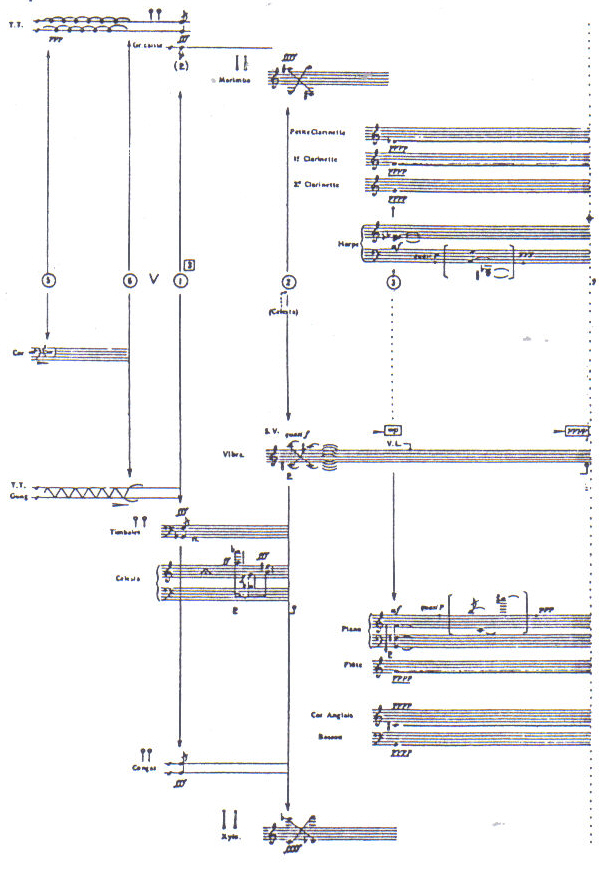
Example 2:
Vibraphone Cluster Before Second Wind Duration
Already by the end of the first
section, the piece's strategy of dialectic transformation is explored. The
intervening rhythmic activity of percussion, harp and piano provoke a slight,
but growing corruption of timbre from the relatively pure clarinet sound of
the first duration to the "graininess" of the third.
Section II (nos. 9-22)
The second section consists primarily of an exposition of polarities
among non-wind instruments: pitched verses unpitched,
loud vs. soft, metallic vs. wood vs. skin, quickly decaying vs. sustaining,
harsh timbre vs. smooth. This interplay of opposites culminates in the wind
duration at no. 19 (Example 3) which is the climactic point of the section.
The characteristics of this sound mass are more complex than in
section I. The texture is dominated by a unison high B the destination of the
cadence from the previous C; and G in the vibraphone (page 6 of the score).
This pitch, at the top of the oboe range and with trumpet muted, can also be
viewed as a climax of increasing timbral complexity
of the wind durations begun in the first section. In addition, this duration is
set in motion by a quick, loud flurry of articulation among winds and
percussion. The high B is colored harmonically by the clarinets lower in
register (concert F B and E) and barely audible (see Example 3). Finally the duration
is carefully notated for a variable decay (not unlike the decay of a plucked
string) with accompanying slight variation of timbre and pitch; flute,
clarinets and oboe have various rates of diminuendo and various cut-off points.
The barely audible concert B in Clarinet I is allowed
to persist briefly after the trumpet B flat has faded away and serve as the
departure pitch taken by the marimba in the following section.

Example 3:
Wind Duration at End of Section II
Section III (nos. 22-52)
As in the previous section, another exposition of percussion, piano,
and harp leads to the further transformation of the wind durations, threatening
their stability as fused sounds. A delicate antiphony between unpitched and pitched sounds erupts into a brief domination
of pitched instruments (page 10 of the score) in a rapid, almost synchronous
texture. The sound mass which follows (Example 4) is fixed only by its unison E
flat and common dynamic; each wind enters and exits independently of the others and
each attack is colored by a simultaneous percussion entrance. The entrances are
carefully orchestrated so that the fused unison E flat
sound expands timbrally from the purer clarinet and flute
to the more complex double reeds and muted brass and back to the c!arinet sound. Thus the timbral
crescendo and dimuendo is symmetrical.
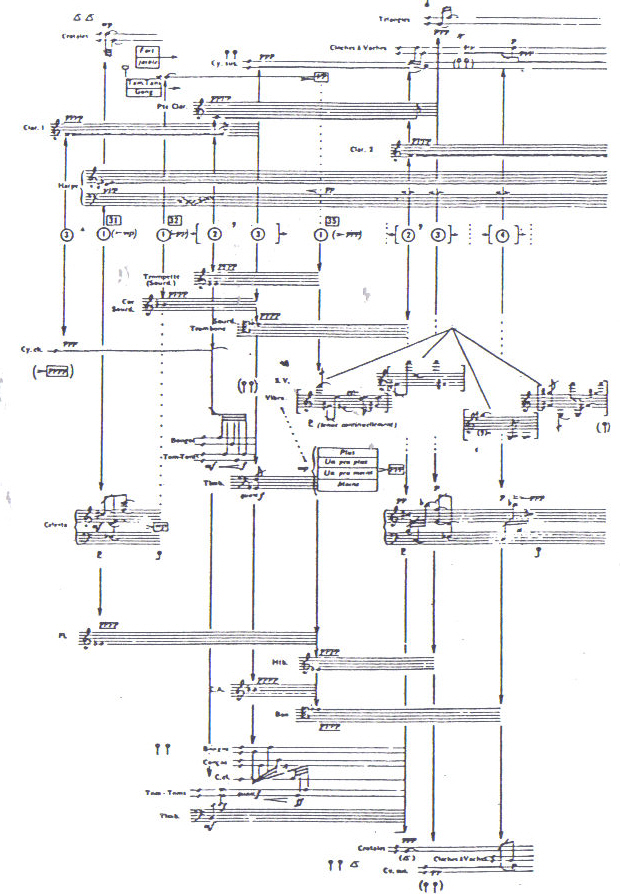
Example 4:
Unison in Section III
The section ends with a reappearance of the
cluster, and in time accumulation of separate wind entrances (see reduction in
Figure 3) in low range, each with fixed dynamics of pppp. This
duration is characterized by varying pitch, timbre and attack (staggered entries) at its
inception, progressing to fixed pitch, timbre and cut-off. In this sense it is
the consequent or obverse to the duration in section II (Example 3) which is in
high tessitura and has reversed characteristics.

Figure 3: Order of Concert Pitch
Entrances of Winds at No. 44 in score.
Section IV (nos. 52-134)
The fourth section circumscribes the advancing
transformation of wind durations to the point at which they become almost
unrecognizable as fused sounds. Vibraphone and celeste
statements culminate in resonance clusters high in range with notes E flat D, A, and G#
(Example 5). These clusters effectively mask the ppp
wind
entrances at no. 62 (the notes of the vibraphone cluster become the highest
notes of the first four wind chords - see Figure 4), perhaps suggesting a
formal link with the vibraphone masking of clarinets mentioned below (page
26). Whereas the wind durations in section I were composed predominantly of
adjacent semitones in mid or low range, these durations (Figure 4) are higher
in range with open spacing of semitones - major sevenths in the clarinets and
minor ninths in the other woodwind choir (hereafter I will call this choir of
flute, oboe, English horn and bassoon the "double reed" choir - with
apologies to the flute). From nos. 62 to 87 the wind durations change pitch in
block-chord fashion, each choir moving independently of the other. However,
since the durations constantly overlap in time, pitch and dynamics, they are
heard as one long legato phrase, a relatively homogeneous sound mass of
strident timbre (caused by interval structure, extreme dynamic,
and very high tessitura).

Example 5: Pitch Elision from Vibraphone and Celeste to Woodwinds at No. 61
in score
The intensification of sound in this phrase sets off a chain
of responses among instruments, much like a jockeying for pre-eminence - which
escalates in intensity and provokes further wind transformations. Loud, surging
gestures from pitched percussion and piano answer the woodwinds and prepare the
ear for the next transformation: from the timbre of woodwinds to brass at no.
85. This first foray of the brass as a choir is carefully scored in mid-range
at mp to emerge from within the surrounding texture, just
as the woodwinds had been masked at the beginning of the section. The elision
and masking of phrase entrances lends a fused, seamless quality to the
escalating swells of intensity directing the piece towards it climax. (As an
illustration of this see Example 5.)
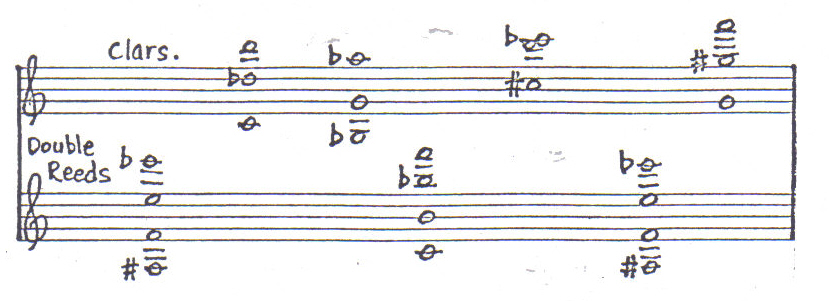
Figure 4:Pitch Reduction of Woodwind Phrase (Nos. 62-87)
Another aspect of transformation is exhibited by the first
brass duration. For the first time, an independent gesture occurs within a
cluster: the trombone C moves to the briefly articulated, but forceful C#
(Example 6). The gesture provokes an immediate and violent response from unpitched percussion which in turn causes a rhythmic
awakening among the woodwinds. At this point, a certain rhythmic consistency
resulting from independent articulations of various instruments begins to
establish itself within each choir's sound mass initiating a gradual rhythmic
accelerando. While there remain continuous and overlapping durations among the
brass, clarinet, and double reed choirs (from numbers
107 to 123 in the score) each instrument, asserting its independence of role,
begins its held note with rhythmic fragments of two or more notes that are
neatly staggered. In an almost "clichëd"
fashion these fragments accumulate in pyramidic addition.
For the first time in the piece, there exists a
relative parity of rhythmic activity, dynamics, and range among brass,
woodwinds, and percussion - in other words, a syncretism of polarities
established at the beginning of the piece. This syncretism is reinforced by the
brief reiteration of concert G# (Example 7) sounded by a representative of each
group: E flat clarinet, vibraphone, piano, oboe,
and trumpet.

Example 6: Initial Brass Duration
in Section IV
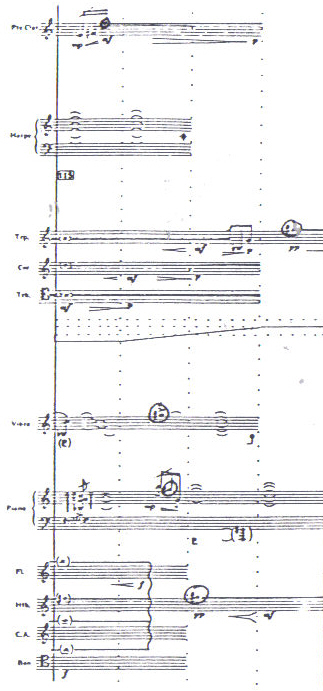
Example 7: Reiteration of G
(circled notes) at no.115

Example 8: Final Phrase of Section IV
At no. 119 in the score, the rhythmic crescendo is diverted
elegantly as the penultimate phrase of the section dissolves into the high, thin
range and quiet dynamic of clarinet and flute. After the brief harp statement at
no. 122, a short phrase elaborates these fragile sounds (Example 8). High winds
and muted brass participate in independently articulated durations of
thin, feeble timbre (within a texture of quiet gongs and harp harmonics). These
durations meander and recycle in a seemingly directionless way, as a relief
from the preceding process of intensification. The phrase is not a
fused duration such as those mentioned earlier, yet it is a block of sound in
which texture, dynamic and range are static. The timbral weights among muted brass, woodwinds, unpitched percussion, harp and celeste
achieve a balance that lends the phrase a homogeneous quality with subdued dynamics,
similar to the earlier durations.
Section V (nos. 135-217)
The rhythmic
liberation of winds and the escalating confrontation among instrumental groups
begun in section IV is now further developed until, by the end of section V,
almost all vestiges of held notes disappear. The process towards complete
disintegration of the wind durations' earlier stability evolves through a
careful shingling5 of elaborations upon durations. Independent
articulations of all pitched instruments alternate at this point among held
wind notes.
The first phrase (numbers 135-153) resumes the rhythmic and textural
development begun in section IV but interrupted by the subdued final phrase of that
section (123-134). Now once again the brass play without mutes,
and all instruments return to a more moderate range and dynamic. A fortissimo
gesture by the piano at no. 152 provokes a response of fortissimo staccatos
from brass and pitched percussion which initiate the second phrase.
Another more
restrained type of rhythmic elaboration also appears in the second phrase
(Example 9). Each clarinet elaborates its note of a
semitone cluster
with adjacent semitones in a slurred and uneven fashion. This relative constraint,
coupled with pianissimo dynamic (within the prevailing fortissimo texture),
gives the duration a "less-highly-evolved" character compared with
the transformations that have already occurred up to this point. The effect of
this "retrogression" is to lend the gradual rhythmic climax of the
section a more complex, less linear, development.

Example 9: Elaboration of Clarinet Cluster at no. 157 in the
score
In the midst of the second phrase (no. 160), unpitched
percussion rolls pre-empt the confrontational character of pitched percussion,
and their gradual crescendos provoke a second chain of even stronger responses.
Another violent burst of brass staccatos, this time matched with thunderous
timpani and tom-tom rolls (beginning the final phrase of the section at no.
197), elicits staccatos from all winds to complete the climax of the piece. By
this point (Example 10), the winds have traversed the entire spectrum of
rhythmic polarity, from subsumption within a fused
duration to independent articulation of staccatos.
Section VI (no. 217-end)
Characteristics
of the processes which directed the piece to its climax reappear, attenuated
and altered, in the final section. There is a return to the qualities of the
first section: relatively sparse texture and quiet dynamics; long durations,
low in tessitura, of predominantly semitone clusters (see figure 5); and freely
articulated gestures by piano, harp and percussion. But the return is a
substantially transformed version of the opening section. The woodwind durations
which began the piece had fixed pitch, dynamic, timbre and
envelope, and they
were subservient to the other instrument groups. The durations which begin the
sixth section, this time played by the brass, take the predominant role, and
their characteristics are much less uniform. Stopped and muted notes in the
horn disturb the timbral unity. Separate entrances,
independent swells of dynamics, and pitch changes - particularly trombone
glissandos - pull against the central pitch and dynamic of each phrase. In other
words, the sustained brass phrases are colored by a residual, much attenuated,
independence of gesture, a faint reflection of their dramatic liberation in
section V. Residues of polar juxtapositions and confrontations are also
present.

Figure 5: Pitch
Reduction by Phrase Brass Clusters in Section VI
Section VI consists
of five brass phrases, the last concluded by percussion and woodwinds. The
first brass phrase (numbers 217-221), ending in fixed pitch, dynamic, and
cut-off, is answered by independent gestures of harp, piano and percussion.
Early in the second phrase (numbers 221-236), as the brass coalesce to a common
pitch and dynamic (the point of least independence),
the piano performs an expressive solo gesture at ffff
- representing
the opposite polarity (Example 11). Joined at number 225 first by the quiet
durations of clarinets, then by the double reeds, the brass phrase swells in
dynamics and timbral complexity (with tile addition
of mute at number 235) and elicits an even stronger response from piano and
timpani at number 236.
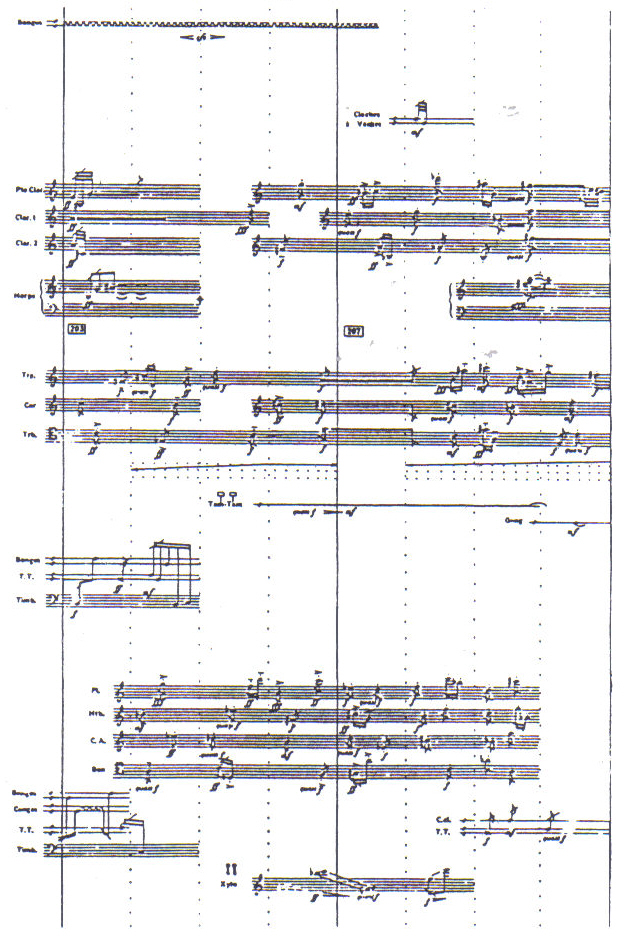
Example 10: Wind Staccatos in the Final Phrase of Section V.
The role of fixed-characteristic, barely audible woodwind
duration, established at the beginning of the piece and heard again in the
double reed choir at number 232, is pre-empted by gong and tam-tam rolls. Their
gradual crescendo in the third brass phrase (numbers 237-255) provokes brief,
independent statements of woodwinds at number 249, anticipating the reversal of
roles which ends the piece.
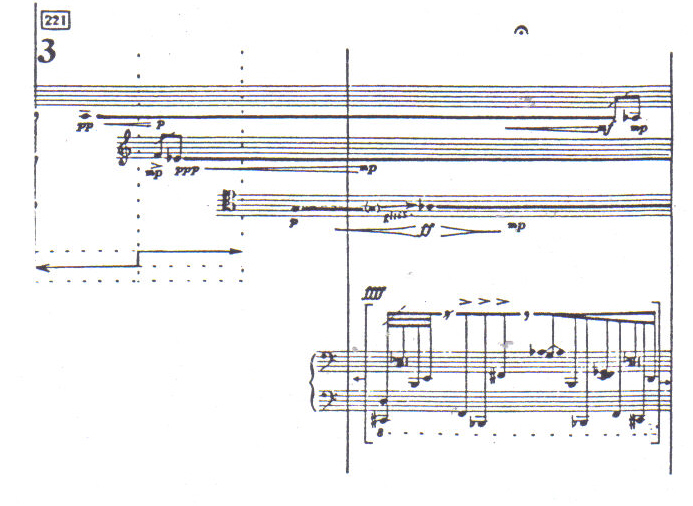
Example 11: Piano Gesture vs.
Unison A in Brass (no. 224)
In response
to the large climax of cymbals, tam-tams, and gongs at number 255, the fourth
brass phrase swells to its greatest height of dynamics and independent motion.
In a final eruption of confrontation, this more forceful assertion of the brass
choir is answered by separate swells of cymbals and one last piano gesture.
The
concluding brass phrase (number 274), a quiet, abbreviated echo of the
preceding phrases, signals the ultimate dissipation of energies in the piece and
the reversal of roles anticipated at number 249. The phrase is accompanied by
individual entrances of tremolos and trills in pitched percussion, celeste and harp which coalesce into a barely audible
semitone cluster of fixed characteristics (Example 12) similar to the woodwind
durations at the beginning of the piece. The cluster forms a drone against which
the woodwinds perform final gestures of short, independent articulations - the
role first voiced by piano, celeste, and percussion.
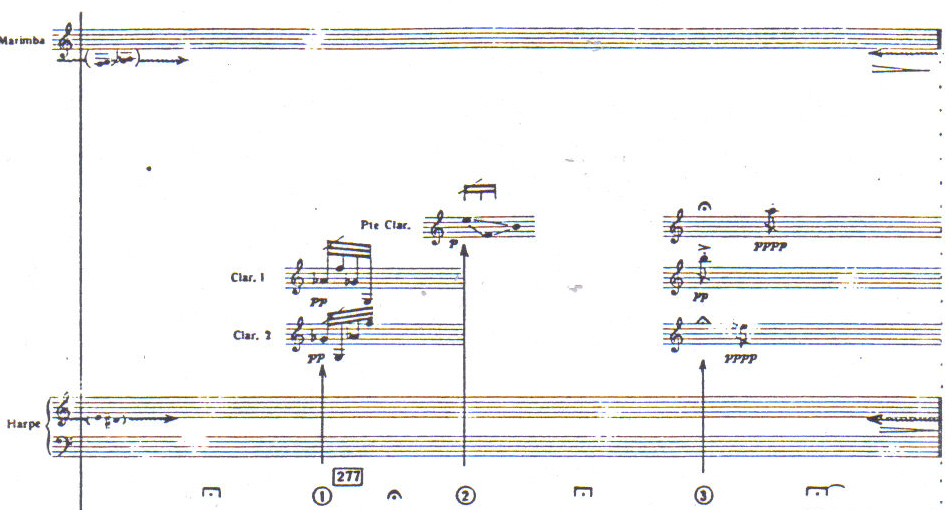

Example 12: Non0wind
Duration and Woodwind Gestures which end Equivalences
Summary: An Analogy
Fire
begin with two opposite elements. The wood is mass in cool and steady
state. The
flame is energy=y in constant motion. When the flame acts upon the wood, there is a dramatic transformation.
What had been a uniform mass becomes differentiated, and certain elements in
the wood become liberated into energy and motion much greater than the flame.
When the fire is spent, smoldering ash, unlike the original flame and unlike
the original wood, remains. The ash erupts into tiny, brief flickerings
of flame until there is no more energy, no motion, and very little mass.
The formal strategy of Equivalence
is partially analogous to a fire. At the outset, highly differentiated
instrumental roles are introduced. The uniform "mass" of the first,
fixed-state wind durations, acted upon by the motion of percussion, piano and
harp, is broken down into decreasingly stable states as energies of independent
movement, range, dynamics, and timbres are released. Polar characteristics of
roles approach and confront one another in a climax of loud, dense, but particulate motion. In the aftermath of
this great expenditure of energy, a cooler, more dormant state returns with
residual flickerings of independence and motion - but
the original elements are quite changed. The last traces of mass are now quiet,
unchanging percussion tremolos, and the last vestiges of energy are the
gestures of woodwinds.
1 Jean-Claude Eloy was born in
Mont-Saint Aignan in 1938. At the Paris Conservatory
between 1953 and 1961, he studied composition with Darius Milhaud
and ondes Martenot with
Maurice Martenot. In 1961 and 1962 he was a student
of Boulez who, with Varèse and Webern,
became an important influence for the younger composer. From 1966 to 1968 Eloy taught at the University of California, Berkeley. In
addition to many chamber works, he composed Shanti
(1975), an electronic work lasting 2 1/2
hours
without interruption.
2 All excerpts from Equivalences
are reproduced here with permission of Editors Heugel
Pars. sole editors, distributors.
3 Opinions
in this paragraph were suggested by Eloy's
descriptions in the liner notes for the Domaine
Musical Ensemble recording (Pierre Boulez, cond.) on
Everest Records number 3170.
4 All numbers noted in this
manner refer to boxed rehearsal numbers in the full score.
5
The
term "shingling", as well as descriptions of fused sound
characteristics are suggested by Robert Erickson in Sound Structure in Music, (Berkeley:
UC Press, 1975).
















